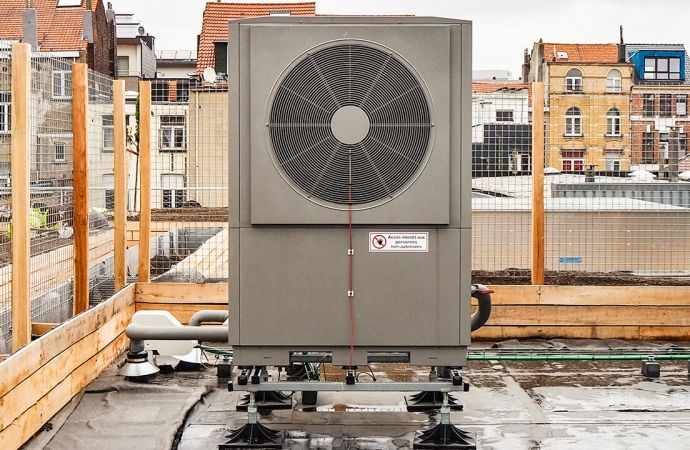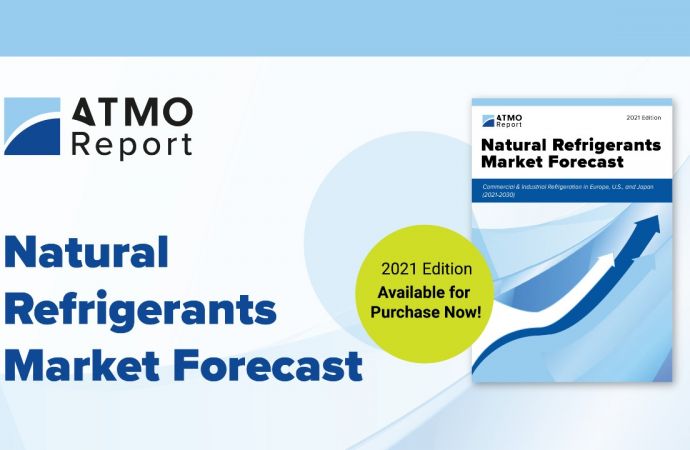Regarded as a climate-friendly alternative to fossil-fuel boilers, heat pumps using natural refrigerants are expected to see growing adoption in 2021.

The Auer heat pump on the roof of a Colruyt shop in Etterbeek, Brussels, Belgium.
The global building sector uses about 32% of all energy generated on Earth, with more than a third of it going to heating and cooling.
Buildings are thus an obvious target for solutions to the climate crisis, according to Project Drawdown, a global climate research project.
This is where heat pumps enter the picture, as they are very energy efficient compared to traditional fossil-fuel boilers, and have dramatically reduced GHG emissions, approaching zero if renewable electricity is used. Therefore, if we only use high-efficiency heat pumps going forward, the energy expenditure for buildings could be reduced by 30% to 40%, Project Drawdown says.
Currently only 3% of global delivered heat comes from heat pumps, but Project Drawdown expects this to increase to 20%-40% by 2050, saving up to 9.3 gigatons of CO2e emissions.
Claus Schøn Poulsen, Center Manager at the Danish Technological Institute, agrees. “A widespread growth for heat pumps is expected [in 2021] as we turn our focus to electrification, and we are about to kick in the door when it comes to small heat pumps for residential housing,” he said.
End users also see the potential in heat pumps. German wholesale giant Metro AG has adopted a Heat Exit Program, to “step out” from using fossil fuels for heating. “Focus is on heat recovery, heat pumps, concrete core activation and natural ventilation,” said Olaf Schulze, Director for Energy, Facility and Resource Management at Metro.
However, it is not enough to switch to heat pumps; they need to be natural refrigerant heat pumps, not HFC ones, according to Menno van der Hoff, Chief Executive Director of TripleAqua Licensing, a Dutch heat pump manufacturer. There is a “future necessity” to use natural refrigerants in HVAC due to tightening f-gas regulations, van der Hoff said during the ATMO/DTI Technical Conference in June 2020, stressing that manufacturers are already adapting and launching more natural refrigerant models. (The conference was organized by shecco, publisher of Accelerate.)
All of the most commonly used natural refrigerants are suitable for heat pumps, according to Poulsen. “Natural refrigerants such as hydrocarbons, CO2 [R744] and ammonia [R717] will in particular apply to large heat pumps, whereas smaller heat pumps will involve the use of hydrocarbons and to some extent CO2.”
Electrification is driving the heat pump water heater (HPWH) market upwards but probably not at the rate it would be pre-COVID. - John Miles, ECO2 Systems
“In certain cases, safety issues related to the use of natural refrigerants lead to HFO refrigerants,” Poulsen added. “ These refrigerants can be a stepping stone towards natural refrigerants, but if there’s ever any doubt, the environment should get the benefit of the doubt. The end game should be to use natural refrigerants in all installations.”
R290 well established
Propane (R290) heat pumps have already made great strides forward in both commercial and domestic applications in the last few years. Belgian retailer Colruyt Group, for example, has started using R290 heat pumps from French manufacturer Auer for store heating, as a supplement to heat recovery from its R290 refrigeration systems.
The heat pumps from Auer are available in capacities ranging from 11-35kW (3.1-10TR), and up to 140kW (39.8TR) when installed in cascade, making them suitable for both domestic and commercial use. They are also highly efficient, with a COP up to 4.9, and capable of producing hot water up to 70°C (158°F), even in ambient temperatures down to -20°C (-4°F).
R744 expanding to new areas
R744 heat pumps are becoming increasingly popular, particularly in the European and Japanese markets, for both heating and cooling. In 2021, “we will see an uptake of CO2 heat pump chillers, as these new products can provide both heating and cooling in a very compact and energy efficient way, not depending on flammable refrigerants,” said Armin Hafner, Professor of Refrigeration at the Norwegian University of Science and Technology.
The U.S. market has been slower to jump on the heat pump trend but here, too, the industry is expecting an increased uptake of CO2 heat pumps next year.
“Electrification is driving the heat pump water heater (HPWH) market upwards but probably not at the rate it would be pre-COVID,” said John Miles, Managing Director, Eco2 Systems. “I would anticipate a 25% increase in the overall HPWH market to 125,000 systems [in 2021].” Next year, Eco2 Systems is planning to introduce a new generation of its CO2 HPWH product line that is 15% more efficient, but the COVID-19 pandemic means the launch is “very delayed.”
There are issues to confront in the U.S. market, one being lack of competition to drive down prices and increase adoption. “There is still a pressing need for more competition in the U.S. market for manufacturers of commercial-size CO2 heat pump systems,” said Andy Baker from Seattle-based YourCleanEnergy. “Unitary cabinet-type CO2 heat pump systems are still limited to Japanese manufacturers with high up-front cost.” For larger systems (approaching 100TR/ 352kW), U.S. manufacturers can be competitive, according to Baker, though they are often still reliant on foreign-made components.
There is plenty of potential, though, in the U.S. market, Baker said, particularly in his own region, the Pacific Northwest. “There are areas in this region with low-cost clean hydro-electricity; facilities with these energy resources can realize the greatest return from a CO2 heat pump system.”
New applications
R744-based heat pumps are also expanding from commercial and domestic uses into much larger industrial applications. “Increasing capacities of the CO2 components opens new markets and applications,” said Kim Christensen, Managing Director of Danish start-up Fenagy. “[For] industrial refrigeration and heat pumps above 500kW (142.2TR), there is a great potential for CO2, to some extent competing with ammonia, of course.” Fenagy is developing a portfolio of R744 solutions ranging from 300kW-2MW (85TR-569TR), with the first products launching before Christmas 2020.
The cost per kW of capacity will still drop, “especially in the higher capacity range, due to the larger capacity [CO2] components,” Christensen said.
Fenagy also expects the efficiency of natural refrigerant-based equipment to improve in 2021 as suppliers and manufacturers strive to optimize. “We have not seen the full impact of using ejectors and expanders yet,” Christensen said.
The U.S. market is also expecting efficiency increases in the coming year. “For transcritical CO2 heat pump systems, we see the largest increase in efficiency coming from smarter integration of this equipment into new or existing facilities, specifically the increased use of low-grade waste heat as a source,” Baker said. “Automatically selecting the lowest-cost source of heat at all the right times brings down operation cost and drives up system COP,” he added, concluding that “it all comes down to good system design.”
R717 making inroads
R717 hasn’t been forgotten by the heat pump market either. “There is growing interest in low-charge ammonia heat pumps, particularly for [government-run] aquatic centers, which are huge users of energy,” said Tony Gleeson, CEO and company secretary for the Australian Institute of Refrigeration, Air conditioning and Heating (AIRAH).
Alternatives to traditional R717 compressor-driven heat pumps are also popping up. U.S. manufacturer Stone Mountain Technologies (SMTI) is developing an ammonia-water absorption heat pump, which is triggered by natural gas, to generate space heating and hot water. The unit is meant to compete with gas-fired boilers, and uses only half the gas of a boiler, while having twice the efficiency, according to SMTI’s CEO Michael Garrabrant.
The units are planned for sizes from 10,000BTU/ hour to 140,000BTU/hour, with COPs expected from 1.6 to 2. The absorption heat pumps were originally planned to hit the market in the beginning of 2021, but due to the COVID-19 pandemic the launch has been postponed to 2022, according to SMTI’s Vice President for Strategy and Marketing Scott Reed.
This article was first published in Accelerate Special Issue #112 – Cooling in 2021.
Related stories



